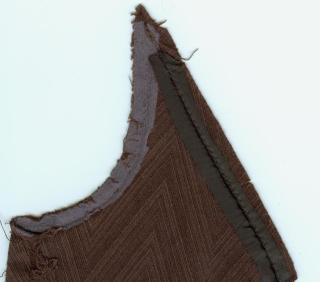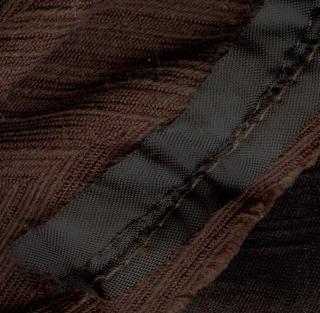Changing a dress into a blazer
13 Nov 2019 09:13 amI just finished reading Overdressed by Elizabeth L. Cline (2011). In it she talks about how fast fashion is bad for the environment, workers, and, well, fashion. One of the ways to she says we can mitigate the effects of fast fashion is refashioning. It was timely because - I did that!
I have been doing that with my clothes and thrift store clothes for years, decades at this point.
Earlier this year, I went through my closet and sorted things into piles: keep, toss, mend, I want a new one, and I wish this were something else.
I made McCall's 7439 c. 1964 size in black corduroy with Bemberg Cupromonium Rayon underlining a few years ago.
I made the collarless version. I thought it would be a nice basic wardrobe piece. It was not.
I've had Simplicity 3369 c. 1960s size 14 on my to-make list for a long time.
Could I get this jacket out of the dress?!?
Since the dress had raglan sleeves and the jacket had set-in sleeves, it looked dicey. I held the jacket sleeve pattern pieces to the bodice pattern piece and kind of held it over the dress. (Suuuuper not technical or precise.)
Surprisingly, the finished dress bodice was pretty much the same exact width as the jacket pattern. The jacket pattern just had straight side seams. I could just reuse the bodice!
The sleeves looked ok? So they could stay attached!
Which was weird because it was a really fitted dress. They were both a size 14 - maybe the pattern companies all used the same fit models and slopers?
But oh well, I just wanted to make something, so I dove in, removed the side zipper, ripped the side seams, took out all the darts, took off the skirt, and started laying out pattern pieces.
I still had scraps in my stash.
So, would there be enough to make it? Yes! Sort of.
The sleeves were almost long enough as is - the cuffs, when undone, were a lot of extra length.
Scraps made up the collar and finished the lapels.
And the corduroy was done. Slivers were leftover.
So sturdy cotton pajama fabric lined the collar and pockets, and extra lining to cover horse hair canvas that should have been under the underlining.
Because the lapels had so many pieces, it's super bulky and won't iron flat. Do the buttons and buttonholes work? No! But I wouldn't be able to button it anyway because it's a little snug.
But I don't care! I love this thing. I've worn it approximately 34 times more than the dress. It's exactly the sort of crumpled, vintage-y looking jacket I wanted.
I have been doing that with my clothes and thrift store clothes for years, decades at this point.
Earlier this year, I went through my closet and sorted things into piles: keep, toss, mend, I want a new one, and I wish this were something else.
I made McCall's 7439 c. 1964 size in black corduroy with Bemberg Cupromonium Rayon underlining a few years ago.
I made the collarless version. I thought it would be a nice basic wardrobe piece. It was not.
I've had Simplicity 3369 c. 1960s size 14 on my to-make list for a long time.
Could I get this jacket out of the dress?!?
Since the dress had raglan sleeves and the jacket had set-in sleeves, it looked dicey. I held the jacket sleeve pattern pieces to the bodice pattern piece and kind of held it over the dress. (Suuuuper not technical or precise.)
Surprisingly, the finished dress bodice was pretty much the same exact width as the jacket pattern. The jacket pattern just had straight side seams. I could just reuse the bodice!
The sleeves looked ok? So they could stay attached!
Which was weird because it was a really fitted dress. They were both a size 14 - maybe the pattern companies all used the same fit models and slopers?
But oh well, I just wanted to make something, so I dove in, removed the side zipper, ripped the side seams, took out all the darts, took off the skirt, and started laying out pattern pieces.
I still had scraps in my stash.
So, would there be enough to make it? Yes! Sort of.
Note: The photos show how wrinkled it is because I'm wearing the heck out of this jacket.
And I loathe ironing.
The skirt made the jacket longer (with pieced lengths), filled in the side seams, and lapel facings (which are pieced). The sleeves were almost long enough as is - the cuffs, when undone, were a lot of extra length.
Scraps made up the collar and finished the lapels.
And the corduroy was done. Slivers were leftover.
So sturdy cotton pajama fabric lined the collar and pockets, and extra lining to cover horse hair canvas that should have been under the underlining.
Worst finishing job on the inside of a jacket ever. Worse than fast fashion, though?
Because the lapels had so many pieces, it's super bulky and won't iron flat. Do the buttons and buttonholes work? No! But I wouldn't be able to button it anyway because it's a little snug.
But I don't care! I love this thing. I've worn it approximately 34 times more than the dress. It's exactly the sort of crumpled, vintage-y looking jacket I wanted.





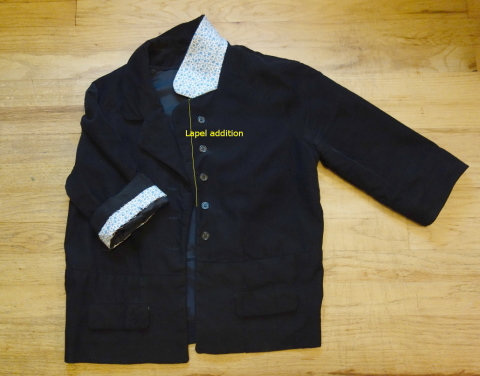







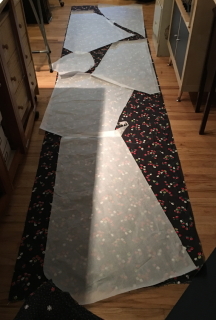

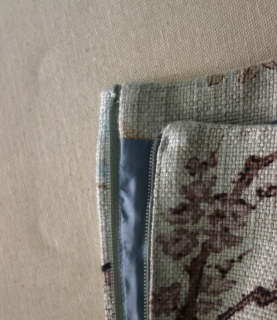








 But like this:
But like this:













